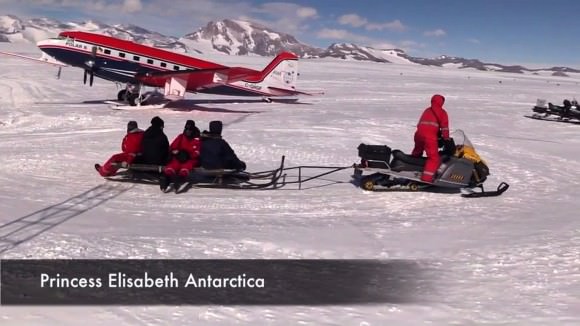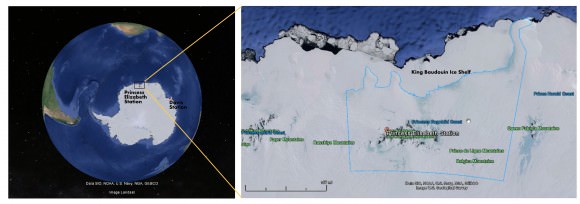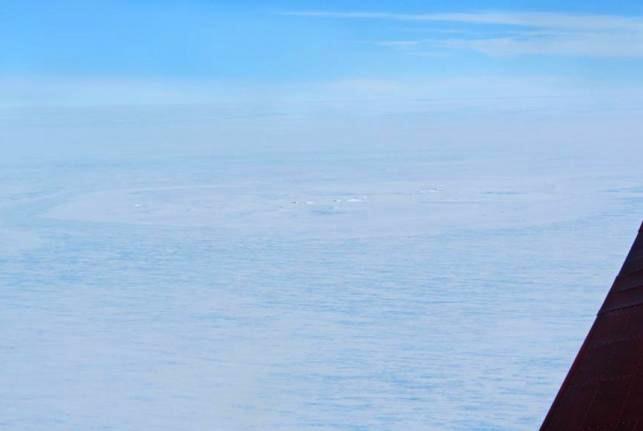Endless blinding white ice as far as the eye can see. This is the common scene from the window of planes delivering researchers to Antarctica. However, this is not always the case. While there are mountain ranges and valleys, for a recent research expedition, a large ringed structure came into view on the King Baudouin ice shelf as they were beginning aerial surveys.
Geophysicist Christian Mueller with the Wegener Institute, Helmholtz Centre for Polar and Marine Research (AWI) in Germany, was looking out the window of an instrument laden plane when the previously unknown ringed formation, 2000 meters (1.24 miles) in diameter, came into view. Looking into research publications, he found evidence that this may be a meteorite impact event from 2004.

The discovery occurred on December 20th from the AWI Polar 6 aircraft as they were flying over the Princess Ragnhild Coast. The formation is located on the King Baudouin Ice Shelf not far from their landing site at Princess Elizabeth station.
Two studies were found in the literature by the researchers which pointed to a possible impact event over east Antarctica in 2004. Triangulation of infrasound monitoring data pointed to the area where the ringed formation is located. The infrasound monitoring sites are located worldwide and primarily used to detect nuclear testing events. On February 15, 2013, the same type of data was used to better understand the asteroid explosion over Chelyabinsk, Russia.

The second study involved local observations. A separate set of researchers, located at Davis Station, an Australian base off the coast of east Antarctica, reported seeing a dust trail in the upper atmosphere during the same time.
Researcher Mueller stated in the AWI provided video, “I looked out of the window, and I saw an unusual structure on the surface of the ice. There was some broken ice looking like icebergs, which is very unusual on a normally flat ice shelf, surrounded by a large, wing-shaped, circular structure.” Altogether, the AWI researchers said that they make the claim “without any confidence.” They intend to request funding to make followup studies to determine its origin.
Cheryl Santa Maria, of the Digital Reporter, also reported that there are survey images showing this structure that date back 25 years. Furthermore, a story by LiveScience quoted Dr. Peter Brown of Centre of Planetary Science and Exploration at the University of Western Ontario as stating that the size of a meteorite is roughly 5 to 10% of the impact crater’s diameter. This would indicate an impactor about 100 meters in size and much larger than the estimated size of the event as estimated by infrasound data from 2004.
The infrasound data estimated that the asteroid was probably the size of a house, about 10 meters (33 feet) across. In contrast, the asteroid that exploded over Chelyabinsk, Russia, had an estimated size of 20 meters. Dr. Brown was quoted as expressing doubt that the formation is an impact site. The effects of a 100 meter object would have been much more distinctive and likely more readily detected by researchers located in eastern Antarctica. Thus, reporting of the ring formation by the AWI researchers is bringing to light additional information and comments from experts that raises doubts. Follow up studies will be necessary to determine the true origins of the ringed structured.


Or… http://www.furiouscinema.com/2011/06/parasitic-paranoia-john-carpenters-the-thing/
Ha, got the Sci-Fi connection! Thanks.
A house-sized rock hit the ice and noone noticed??? Imagine how many rocks of (almost) all sizes hit the oceans unnoticed. So we’re far away from total safety; we’ll see it comming… but much too late for reaction (as Russia prooved).
Many do literally blind-side us by approaching from near the direction of the Sun; hidden in the glare. Also, while 20 meters is a risk to a city sized area, they are dim objects and not always detected even outside the sun’s glare because observations are not covering the southern hemisphere very well at this time. Siding Spring Observatory was doing service and I do not know of a program that has taken its place.
So the “crater” was a thermal event enhanced by the blast/shockwave ?
Can’t wait to see microscopic pictures of the sampled ices and analysis from the spectrograhs.